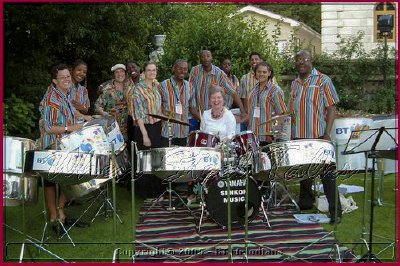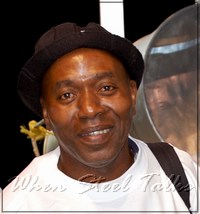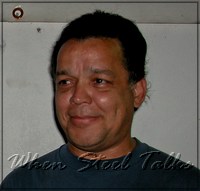Trinidad & Tobago, W.I.
TIME FOR ‘CONGRATS’
 Today I am in a congratulatory state of mind as I send out greetings to Terrence Noel and his BT Melodians in lonely London, England on the fine work they are doing spreading the Gospel of Pan. These Pan troubadours have been touring the world flying the British flag in the name of Pan. They have taken pan to the Middle East, Asia, and far-flung places. Hooray!
Today I am in a congratulatory state of mind as I send out greetings to Terrence Noel and his BT Melodians in lonely London, England on the fine work they are doing spreading the Gospel of Pan. These Pan troubadours have been touring the world flying the British flag in the name of Pan. They have taken pan to the Middle East, Asia, and far-flung places. Hooray!
I thank God their efforts have not gone unnoticed, because just a few days shy of the historic tour by the, Trinidad All Steel Percussion Orchestra (TASPO), comes the exciting statement that “the steelband is part of British culture.” I like that too bad. I like it more than cooked food. You think I vex? I happy like a golden posey. I repeat: I love it more than a curry pelau with hog features.
Now that statement was made by the British Ambassador to Vienna, Mr. Simon Smith when the BT Melodians toured there, and celebrated the birthday of Queen Elizabeth II. Today I want to thank Ambassador Smith for recognizing Pan’s worth and value to the British society. As an old colonialist, myself; I really feel to kiss the man big toe..... and who vex lorse.
In Pan’s native land [Trinidad & Tobago], we are yet to recognize its value in a serious way. Panmen still have problems, and are treated like an outside child, or a ‘dorg’ (my word). Pan is only taken seriously when politicians want to use the Pan, and deejays want to defecate on Panmen. I am glad Ambassador Smith is saying “Pan is we ting.” We continue to bump our gums with our Listerine mouths, paying only lip service to Pan. I will forever praise those who love the pan whether they are “foreign” or local.
Cultural activist and pan jumbie Pat Bishop once said “we don’t deserve the Pan” and she is so right. Now I expect Switzerland, Germany ,Holland and Denmark to say Pan is part of their culture. Hooray! Bring it on guys. You think I vex? I love it more than cooked food.
Just imagine in ‘Pan country’ [Trinidad & Tobago] a Minister of Culture could rail against Panmen and Pan Trinbago - talking about accountability and transparency, and was found wanting owing the government dollars over the years, the latest being one million. Now this is taxpayers dollars we are talking about, not his money. This is the same man who refused to pay Panmen their TT $1000 stipend, and when they protested threatened - them and started to talk big...like a big Tanto! He really lucky panmen awoke before the cavemen.
In a so-called Cabinet reshuffle he retains his post. How’s that for hypocrazy... not hypocrisy? That’s why when a Britisher [British Ambassador to Vienna, Mr. Simon Smith] say “Pan is we ting”...... I love it more than cooked food..... I love it, I love it - more than my former wife. Pepe Francis of the British Association of Steelbands, take a bow for 30 solid years of pan in Britain. You reach!
TIME TO LOOK AT THE G-PAN AGAIN
The time has come to look at the G-pan (Genesis pan) with a view to making it more practical. Pepe Francis, Chairman of the British Association Of Steelbands, is of the view that the pan should be scrapped. I don’t think so; I feel we should re-engineer the Pan with a view to making it more light-weight. I’ve heard tuners and panmen complain the Pan is an exercise in weightlifting. Now we really don’t want to see panmen with hernias do we? Nobody is listening to these complaints. Pepe also pointed out that designer drums are available in London (Coventry), Denmark and Holland. Why can’t we look at metals and how they could enhance the sound of the pan? But what are we doing? Sitting on our hand or playing pocket billiard.
I have been clamouring for a Pan Development Institute where young inventors could go and express themselves. This institute could be tied in with UWI (University of the West Indies) and the brilliant Dr. Brian Copeland and his team.
Government must stop ‘funding ole talk’ and start with solid projects like the Philharmonic Percussive Instrument - the PHI (pronounced “fie”) Pan, and invest in its large-scale development. There’s money to be made in Pan technology....it’s Pan’s final frontier. We must put young engineering inventive minds to work. The G-pan should be a work in progress; but then you’ll hear the familiar refrain....no funding.
PAN JAMMING ON CHARLOTTE STREET
The Renegades Pan Theatre will come alive with the sound of steel when six hot bands pelt out music at 8 p.m. It is the first fund-raising project of the innovative grouping PAN LOVERS INTERNATIONAL. All bands have come on board, as the Pan Lovers - once thought of as a rival organisation to the ruling Pan body - get down to work, with the aim of helping Pan pioneers in their dying (no pun intended) days, establishing a secretariat, an All-Pan radio station as well as other ideas.
For only one blue note (TT $100) you can get a delectable diet of Petrotrin Phase Two Pan Groove, Couva Joylanders, Woodbrook Playboyz, T&TEC Tropical Angel Harps, Bptt Renegades and Defence Force, now celebrating 16 years.
Panmen and pan enthusiasts don’t forget to dress up as the bands and Pan Lovers pay tribute to men from TASPO who left these shores 60 years ago.
________________
Until next week, wherever you are in Pan’s Diaspora, keep on loving The Pan. Bless.





